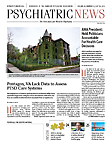For decades, researchers have suggested that glutamate is the most prominent excitatory neurotransmitter in the brain, yet its specific role in psychiatric disorders is still unclear. To shed light on the actions of glutamate, a team of scientists from Massachusetts General Hospital investigated how dysregulation of the glutamatergic system can have negative consequences for mental health—in particular, bipolar disorder in children and adolescents.
“There has been an increased interest in glutamatergic regulation in both adult and pediatric bipolar disorder,” Andrea Spencer, M.D., an instructor and researcher in psychiatry at Massachusetts General Hospital, said in an interview with Psychiatric News. “What is interesting for us as child and adolescent researchers is that glutamate is involved in the development of the brain.”
As the major excitatory neurotransmitter, glutamate plays a critical role in brain function, adaptation of the brain in response to external stimuli, and brain maturation. Malfunction of the glutamatergic system has been associated with multiple psychiatric disorders, many of which have their onset in childhood, Spencer said.
“We know that mood disorders often start in childhood,” she noted. “It is very important that we not only investigate the association of glutamate with the pathophysiology of adult bipolar disorder, but also investigate such association as it relates to pediatric bipolar disorder.”
To explore whether such a link exists, Spencer and colleagues conducted a systematic review of the literature that examined glutamatergic dysregulation as it relates to all psychiatric disorders in children and adolescents. To meet inclusion criteria, the studies were required to have measured glutamatergic metabolites—glutamate, glutamine, or both—via magnetic resonance spectroscopy (MRS), a noninvasive method that detects protons of a chemical compound in a specified region of the brain.
The results, which were presented at an APA annual meeting session in May titled “Advances in Pediatric Bipolar Research,” showed that decreased concentration of glutamatergic metabolites was consistently associated with children who had a diagnosis of bipolar disorder, compared with those without a bipolar disorder diagnosis.
Metabolite levels were more likely to normalize in those who were administered medication as a treatment for the mood disorder.
In addition, major depressive disorder in children was associated with low levels of glutamatergic metabolites, while other psychiatric disorders, such as attention-deficit/hyperactivity disorder and autism spectrum disorder, were found to be associated with elevated levels of glutamatergic metabolites.
“It was important that we looked at all child and adolescent psychiatric disorders, because there can be so much overlap [such as in symptomatology] of the disorders,” Spencer explained. She said that the research approach was necessary to assess the potential for biomarkers—such as glutamate—to predict pathophysiologies of specific mental disorders in youth.
Spencer noted that the current findings from her group have generated numerous hypotheses about glutamatergic regulation in bipolar illness and other psychiatric disorders that develop in childhood.
“Right now we do not know a lot about the variability of glutamatergic metabolites in bipolar disorder. We really hope that this specific work will catalyze interest in examining glutamatergic regulation in child and adolescent psychopathology,” Spencer concluded.
The research was supported by the Pediatric Psychopharmacology Research Council Fund. ■
A video interview with
Psychiatric News can be accessed
here.

